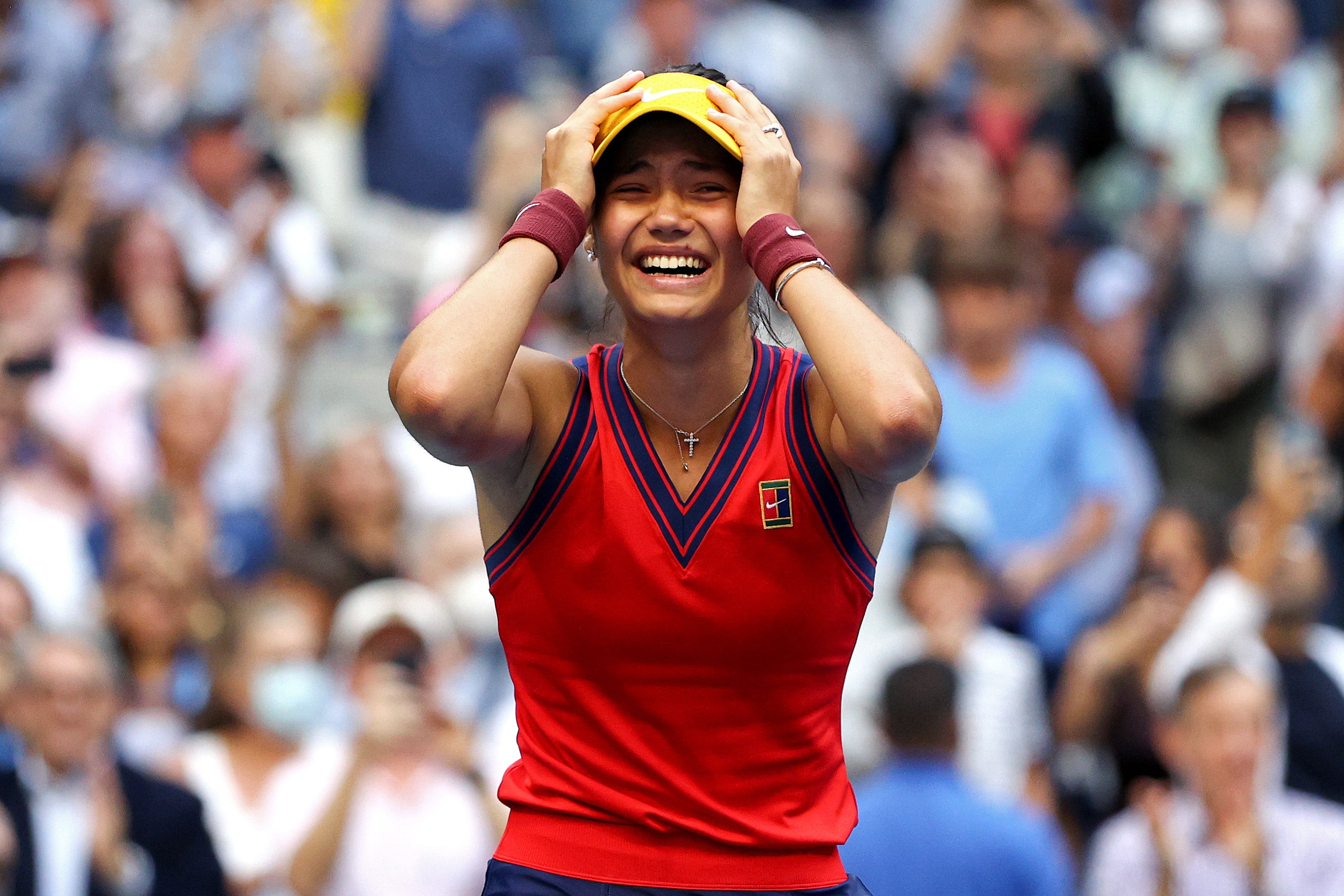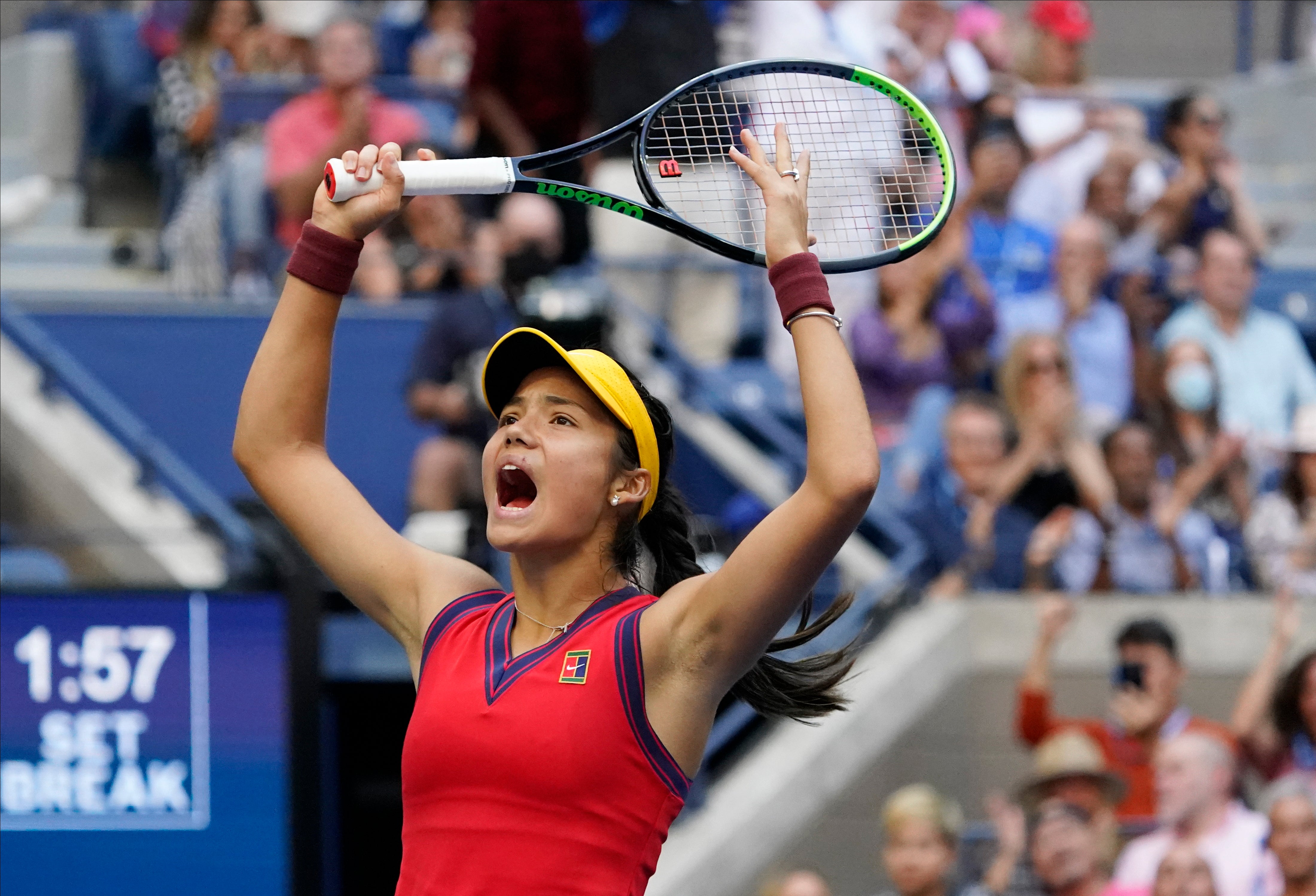
Sporting fairytales can all too often have unhappy endings, but Emma Raducanu’s extraordinary run at the US Open finished in glorious fashion in New York as the 18-year-old became Britain’s first female singles Grand Slam champion for 44 years.
Raducanu, the first qualifier ever to reach a Grand Slam final, once again rose to the occasion, beating the 19-year-old Canadian Leylah Fernandez 6-4, 6-3 with a remarkable display of big hitting and composure. Just three months after making her debut on the main women’s tour, Raducanu became the youngest Grand Slam singles champion since 17-year-old Maria Sharapova won Wimbledon in 2004. She is also the first woman ever to win the title in only her second Grand Slam tournament.
Among those in the crowd in Arthur Ashe Stadium was Virginia Wade, the last British woman to win a Grand Slam title, at Wimbledon in 1977. Wade was also the last British woman to win in New York, having won the very first US Open of the open era in 1968.
Although Raducanu was born in Toronto to a Chinese mother and Romanian father, she is very much a product of British tennis. Her family moved to Britain when she was two years old and she has always competed as a British player. The BBC might as well cancel the voting in their 2021 sports personality of the year contest now.
Raducanu had made her Grand Slam debut at Wimbledon, where she became the youngest British woman in the open era to reach the fourth round. As the world No 150, she is the lowest ranked player ever to win the US Open, though Kim Clijsters did not even have a world ranking when she won the title in 2009, having just returned to competition after having a baby. Raducanu will now climb to No 24 in next week’s updated world rankings list.

Having come through qualifying, she lifted the title by winning nine matches in the space of 17 days and without dropping a set in any of them.
Fernandez played her part in a final of the highest quality. The Canadian had only ever beaten one top 10 player before this tournament but had overcome three top five players en route to the final in the shape of Naomi Osaka, Elina Svitolina and Aryna Sabalenka. The current world No 73, she will climb to No 32 next week.
The first Grand Slam final contested by two teenagers since Serena Williams beat Martina Hingis in the same stadium in 1999 was a thrilling display of talent and athleticism. Both teenagers struck the ball with immense power and exquisite timing, but their court coverage was equally impressive as they repeatedly got back balls that might have been winners against lesser opponents. If Raducanu had the edge in shot-making and power, Fernandez had the greater variety, exemplified by some devilish drop shots.
Neither player would have needed reminding about the significance of the occasion, but it was underlined when they were joined on court before the match by Billie Jean King and five other members of the “Original Nine”, whose bold stand in 1970 paved the way for the establishment of the modern-day women’s tour.
The first Grand Slam tournament to be played in front of full houses since the outbreak of the pandemic has seen the crowds at fever-pitch for much of the fortnight, their excitement heightened by the remarkable progress of so many young players.

Both Raducanu and Fernandez have enchanted the fans with their dynamic tennis and engaging personalities, but from the start it was clear that the majority of the 23,500 spectators in the cavernous Arthur Ashe Stadium were supporting the Canadian. On this occasion North American solidarity overrode any special transatlantic relationship.
The two women have known each other for many years since their junior days. They had never previously met at senior level, though Raducanu won in straight sets when they played each other in the second round in the Wimbledon girls’ singles three years ago.
Raducanu had made slow starts in some of her previous matches in New York but the Briton, showing few signs of nerves, was quickly into her stride, holding serve in the opening game with some bold hitting. When Fernandez served she was immediately put under pressure by Raducanu’s crunching returns. The Canadian saved five break points in her opening service game, but on the sixth she could not handle another jet-propelled return.
From 0-2 down, Fernandez fought back in gritty fashion. Now it was Raducanu’s turn to fend off break points as her opponent turned up the pressure with some aggressive shot-making. On Fernandez’s fifth break point the Briton netted a backhand. The first three games had taken 23 minutes.
There was no let-up in the quality of the play as both women held until Fernandez served at 4-5. At 15-30 Raducanu went to set point with a thumping backhand crosscourt return before Fernandez rallied to deuce. The Canadian then saved a third set point, but on the fourth Raducanu hit a thunderous forehand winner down the line.
When Raducanu held serve at the start of the second set and then had her opponent trailing 0-40 in the next game it seemed that she might have taken a decisive grip on proceedings, but once again Fernandez showed her resilience to win the next five points, including the last three with unreturned serves.
Fernandez then broke serve to lead 2-1, but Raducanu’s response was magnificent. Breaking back for 2-2 and then holding for 3-2, the Briton then broke again with one of the shots of the tournament with a counter-punching forehand pass that appeared to leave Fernandez in disbelief at the net.
At 2-5 Fernandez saved two match points, the first with a big forehand and the second as Raducanu netted a forehand. At 30-30 in the next game Raducanu slipped as she failed to return a ball out wide, cutting her left leg on the playing surface. The Briton had to take a medical timeout for treatment but saved the break point on her return and eventually went to a third championship point. This time she made no mistake, hitting a superb ace out wide to clinch her victory after an hour and 51 minutes. It was a fitting end to one of the most remarkable runs in the history of women’s tennis.







